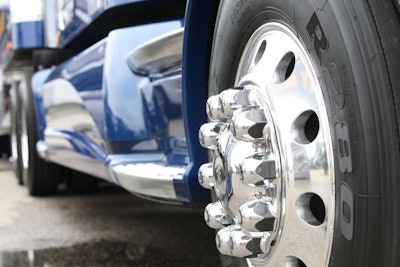 Lightweight aluminum wheels such as Alcoa’s DuraBright line have gained widespread acceptance throughout the industry.
Lightweight aluminum wheels such as Alcoa’s DuraBright line have gained widespread acceptance throughout the industry.Savvy fleet managers know every truck component is vital for a successful and profitable operation. That said, it’s only natural for fleets to overlook the modest wheel on something as complex and dynamic as a modern truck. A wheel admittedly has no moving parts – although it could be argued it is, by definition, the ultimate moving part – and if it is spec’d properly and undamaged, it usually performs flawlessly and offers little or no reason for adjustment.
That said, properly spec’ing wheels can help optimize fleet operations in a surprising number of ways, from easing maintenance demands, slashing vehicle weight, boosting fuel economy or even helping with driver retention – all of which make wheel specs definitely worth a look.
Two basic wheel types dominate today’s heavy-duty market: Steel and aluminum. While the rule of thumb is that aluminum wheels are for lightweight applications and steel is for everything else, in reality things aren’t that simple.
“There are a multitude of specs available for both steel and aluminum to fit a wide range of applications,” says Robert Flynn, director of product marketing for Accuride. Such specs include lightweight steel options for fleets in tougher applications but still concerned with weight or fuel savings.
Accuride manufactures and sells both steel and aluminum wheels because many fleets need both options, Flynn says. “Our lightest-weight steel wheel weighs 66 pounds,” he says. “For many fleets, that’s an attractive spec.”
While aluminum wheels cost up to three times more that those made of steel, most long-haul fleets looking to take all possible weight out of a tractor are willing to pay that premium, Flynn says. “Light weight obviously helps with fuel economy,” he says. “Likewise, fleets that tend to weigh out before they cube out can take on additional cargo and generate more revenue.”
 Accuride says it manufactures and sells both steel and aluminum wheels because many fleets need both options.
Accuride says it manufactures and sells both steel and aluminum wheels because many fleets need both options.The weight savings with aluminum wheels can be impressive. Alcoa invented the aluminum truck rim in 1948, and today aluminum wheels have gained widespread acceptance throughout the industry, says Brian Thomas, marketing manager for the company.
“Alcoa’s most drastic weight savings package with aluminum wheels saves fleets 1,400 pounds per vehicle,” Thomas says. “That’s a 14-inch wide-based tire configuration that cuts typical weight on the drive axle down from 130 pounds to 58 pounds.”
Those numbers work in a fleet’s favor even more when fuel and maintenance savings are considered. “Fleets will typically see a 30 to 40 percent upcharge for aluminum wheels at purchase,” Thomas concedes, “but resale value for aluminum wheels alone results in a 75 percent return on that investment up to 10 years later.” More immediate are fuel savings and additional freight revenue. “Depending on usage, application and the number of miles run, some fleets can see a ROI for aluminum wheels in a year or less,” he says.
Steel wheels remain an important option for many fleets, however – particularly those engaged in severe-duty or off-highway applications. “We do see some fleets over-spec for weight savings,” says Mark Fonte, marketing manager of OE sales for Maxion. “Fleets who are concerned with weight sometimes don’t realize there are lightweight steel options available that will hold up better in some tougher applications. We’ve optimized our lightweight steel wheel options to help them avoid the additional cost of aluminum wheels while giving them the tool they need to get down and dirty with their trucks.”
While aluminum wheels are less maintenance-intensive than steel wheels, Fonte says that Maxion has developed technologies to help steel wheels last longer between refinishings that typically are needed every two to three years in most fleet applications.
“We’ve been offering our triple-layer powder-coat protection as standard since 2009,” he says. “Our in-house testing combined with real-world results shows those wheels lasting up to four times longer than other untreated rims before a refinishing job is required. It’s a huge boost to maintenance operations, and those savings can really add up over a large fleet.”
Regardless of whether it’s steel or aluminum, wheel manufacturers agree on one point: Spec’ing wheels that provide a comfortable ride is another weapon in the never-ending battle of driver retention.
“That really works on multiple levels,” Flynn says. “Drivers like to sit behind the wheel of a sharp-looking truck, and shiny wheels certainly help with that image. Plus, good-looking rims are an important part of the overall vehicle look for fleets that consider their trucks to be ‘rolling billboards’ for their businesses.”
Fonte cites runout – “the straightness and trueness of the wheel” – as a critical factor when spec’ing for a smooth ride. “Quality wheel manufacturers know that the more you do to improve overall comfort and rideability in a truck goes a long way toward helping with driver retention,” he says. “Drivers who aren’t worn out after a long day in a good-looking truck are going to be happier than drivers who don’t enjoy those workplace advantages.”













